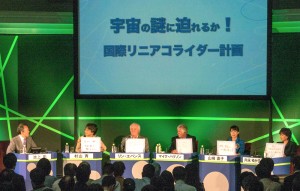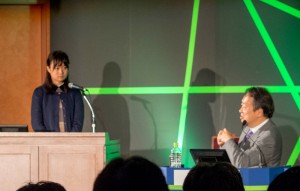
Panelists at the ILC Symposium in Tokyo (From left, Akira Ikegami, Hitoshi Murayama, Lyn Evans, Mike Harrison, Naoko Yamazaki, Yukako Uchinaga)
Despite the largest typhoon in the year approaching, about 300 people braved the elements and gathered at a conference hall at University of Tokyo on 15 October. A symposium entitled “Can the ILC solve the mystery of the Universe?” was held, with representatives from Linear Collider Collaboration (LCC) and specialists from various fields.
The symposium was opened with a speech by Lyn Evans, director of the LCC. It consisted of two parts: two talks by Hitoshi Murayama, deputy director of the LCC, and Hideaki Omiya, Chairman of the Board of Mitsubishi Heavy Industries, Ltd, and a panel discussion. In addition to Evans and Murayama, Mike Harrison, LCC’s Associate Director for ILC, Yukako Uchinaga, Board Chair of J-WIN (Japan Women’s Innovative Network), and Naoko Yamazaki, Astronaut, joined the panel. The discussion was led by Akira Ikegami, a journalist who is known in Japan as a person who explains any topic, no matter how difficult it is.
The panel discussion started with the video clip about the 2013 Nobel prize in physics, which was awarded to François Englert and Peter Higgs and for their work on the theory of the Higgs boson, discovered at CERN in 2012. Moderator Ikegami showed himself surprised by the comment made by Murayama that he did not believe that the particle like Higgs boson exists. Murayama said, “Higgs boson is a pretty strange particle. It is a sort of ‘faceless’ particle without spins. It feels strange to think there is some faceless species in this world.”
Yamazaki, the second Japanese female astronaut who went to space on the space shuttle Discovery as part of mission STS-131 in 2010, is of course a prominent scientist. She commented on the 2013 Nobel prize “My first impression was ‘well, what is the Higgs particle?” drawing laughter from the audience. When CERN announced the discovery of new particle in July last year, Yamazaki said she felt a bit impatient because CERN did not announced the discovery very clearly. “I wondered why, but then I learned that in order to announce a discovery it takes a lot of precise analysis. I was so impressed.”
The Higgs particle is said to give mass to particles in the universe. “But we do not usually think of the difference between mass and weight,” Ikegami talked to Yamazaki about her experience in the space. “In the microgravity environment of the International Space Station, we realise what mass is.” The experimental equipment weights as heavy as 500 kilograms on the earth. It becomes weightless in space, but we still feel the mass when we move and catch it.”
Last August, the ILC site evaluation committee of Japan announced the result of the assessment on the two candidate sites in Japan, and they recommended the Kitakami mountains in the Iwate and Miyagi prefectures as a best suitable location. Evans said, “It would be best to have the LHC (Large Hadron Collider) and the ILC operating at the same time. I strongly hope that Japan takes initiative for the ILC.” Harrison said, “For the ILC, the technology is mature, and the physics case is bold. The remaining issue would be the finance,” expecting the start of the international discussion between prospective participating countries.
In the panel discussion, important input from the younger generation was presented from a future scientist and an educator. Mie Yamanaka, a senior high school student, is part of a programme provided by Tohoku University to train future scientists. Yamanaka wishes to pursue the medical profession, and is studying about cancer treatment at the training programme. Yamanaka said, “I learned that the ILC has a lot of potential for practical applications, and I got interested especially in the medical applications.” Now she is joining a research group of other high school students whose future interests are varied, such as astronomy, agriculture, or education. She said that she would like to know more about the ILC, and “I would like to propose the ILC community to provide a workshop with specialist in many fields for students, so that we can have more clearer picture of what is the ILC.”
Another important input was made by Yosuke Gotoda from Nara University of Education. The university provides a special programme to cultivate “Super Science Teachers”, science teachers with high-level knowledge and communication skills, and Gotoda wishes to become such a super teacher, because he believes that the key persons to bring up the children’s understanding of science are teachers. Gotoda has helped the science educational programme at KEK, and “I started wondering. Every participant in the programme said it was an interesting experience, or science is fun to study. But, how many of them keep that interest after the programme? We need some activities to make them maintain their interest. I think the ILC will be the core laboratory for such activities.”
The panel also discussed issues related to establishing the ILC international city. Ikegami pointed out that even if the ILC project is approved now, it will take another 15 to 20 years for the accelerator to start running.
Uchinaga, the top female business leader in Japan, who became the first woman from outside the United States to be inducted into the Women in Technology International Hall of Fame in 1999, said that despite it seems a long time, it will come very soon. “There are many issues to address to realise such a big project. Rather, we have little time left.”
Murayama explained the difficulties he had when he came back to Japan after the long stay in the US. “I could not get a credit card, because I did not have any working records in Japan. I had difficulties to buy a cell phone, because I did not have a street address in Japan. Even though I am Japanese, and speak Japanese, I still had many troubles.” He emphasised the need for change in the institutional procedures and systems.
Uchinaga said that hosting the ILC in Japan will change the mindset of Japanese people. “So far, the meaning of the globalisation in Japan was to go abroad. With the ILC laboratory, we can realise globalisation from inside Japan. I expect the ILC to become a core of those changes.”
Yamazaki has lived in the US for her training at NASA. “NASA has a great programme called family support for the astronauts, and I received great help. The ILC may need something similar to support scientists and their families.”
The symposium was closed by messages to the ILC from each panelist. Evans wrote “Golden opportunity for Japan” on his board, and Murayama “Let’s solve the mysteries of the universe together.”
Ikegami concluded that the ILC may be the huge chance for Japanese society to change, and the great opportunity to consider the future of the country.
The symposium was well received by the audience. The survey result showed 90 percent of the audience found the symposium “interesting,” and 86 percent said it was easy to understand. The symposium will be edited to a TV programme and broadcast on the education and international channels. The date of the broadcasting to be announced on NHK’s website.


Recent Comments